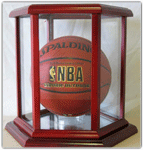The wide world of sports evolves via RFID
 Golf balls, race cars, runners, pigeons all tagged in the name of the game
Golf balls, race cars, runners, pigeons all tagged in the name of the game
By David C. Wyld, Contributing Editor
The wide world of sports is no doubt one of the sexiest applications for RFID on the horizon, and innovative companies across the globe are rushing into sports applications for the technology. We are seeing that the games and races themselves can be enhanced through the use of RFID technology and we are seeing that RFID can be used to create new metrics – as well as new gambling opportunities – in the sports world.
RFID on the field
Exciting, in-event applications of RFID technology are changing the way we play and watch sports. The most noteworthy team sport example to date comes from the world of soccer. The Erlangen, Germany-based Fraunhofer Institute for Integrated Circuits has developed an RFID-based system to give complete visibility to the soccer field. Both the ball and a shin-guard on each of the players are outfitted with RFID-chips. Readers positioned to scan the entire field track the location of both the players and the “Smartball” up to two thousand times each second. The Fraunhofer system can enable referees to consult the data to aid in disputed goals and troublesome offsides penalties. It also allows soccer clubs and their fans to access performance metrics on their teams and individual players. The system, which is being tested by Adidas and by soccer’s world governing body, FIFA, is likely to be approved for tournament use this year.
RFID on the links
Probably the most intriguing individual sport prospect is on the golf course, as anyone who has picked-up a golf club has been there. You hit your drive off the tee, and it goes, and goes, and goes – where? Most golfers have spent countless hours combing the banks of creeks, looking in crevices, and pouring through thickets in often fruitless searches for their wayward shots. But what if there was a high-tech way for the ball to tell you where it was and guide you to it? Radar Golf, based in Roseville, California, is seeking to RFID-enable the game with its Radar Golf System. Such a prospect led Stephanie Stahl, the editor of InformationWeek, to say that finding lost golf balls may be the “killer app” for RFID in the consumer world.
Radar Golf’s ball, manufactured by a Chinese contractor, has an RFID tag embedded inside its core. The ball has been certified as conforming to the rigorous standards of the United States Golf Association (USGA), enabling it to be used in tournament play. The company’s patented Ball Positioning System (BPS) is built into a handheld unit, which is essentially an RFID reader that transmits a specific radio frequency signal to search for the lost ball. It provides a visual LCD signal strength display and pulsed audio tone feedback to the golfer during their search, with the beep increasing as the golfer nears the location of the wayward ball. The BPS presently has a detection range of up to 100 feet. The company began marketing the system in mid-2005. The Radar Golf System retails for $249, which includes a dozen golf balls (additional dozen balls sets retail for $39). It plans to license the technology to other golf ball manufacturers to equip their branded balls with RFID tags.
RFID goes to the races
RFID can add value and visibility to racing events of all types. One of the longest standing applications of RFID has been in the area of marathon racing. The ChampionChip Company pioneered the use of RFID-chips attached to runners in the Berlin Marathon in 1994. Since then, the firm’s namesake tracking device has been worn by millions of road racers, cyclists, in-line skaters, cross-country skiers, and triathletes in events worldwide. The tracking device, which uses passive RFID technology with antennas built into specially-designed mats over which the athletes must pass, allows for the racers’ real, net times to be recorded as they pass the start and finish as well as other intervals along the course.
It also brings the “value-add” of real-time tracking via the Internet for friends, fans, press, and family members. It has been used in the New York City Marathon, where 5,000 runners per minute crossed the 36 meters-wide starting line at the Verrazano Narrows Bridge. And in the June 2000 Broloppet half-marathon, in which runners raced across the new bridge connecting between Denmark and Sweden, a record 79,837 competitors were tracked using the ChampionChip. Commenting on the state of marathon technology, Judith Donohue, manager of the HP’s New England Initiative, whose firm has worked with the Boston Marathon for over a decade, observed: “We’ve come a long way from when we used to draw a line in the street with chalk.”
RFID at the speedway
RFID has moved into a wide variety of motor racing outlets. Texas Instruments has developed the Race Timer system for motorcycle racing, in which an RFID transponder is placed either on the motorcycle’s front fender or in the rider’s chest protector. The system is a quantum improvement over the former use of single-file gates and either manual recording or scanning barcodes attached to riders’ helmets. With the TI system, the size of motorcycle events can grow significantly, supporting up to 1,000 riders in a single event. RFID has also been adopted by the IRL (Indy Racing League), with active transponders being positioned in the same point in the nose of the Indy Car and with antennas positioned around the track. With speeds of over 200 mph, the system can distinguish between two or more racecars passing the same point within a minute fraction of a second of each other. The system allows for real-time race tracking via the Internet for all IRL races, including the Indianapolis 500, where antennas are installed in the track surface in the Indianapolis Motor Speedway.
While NASCAR has not announced a similar in-race system, the fast-growing racing circuit is employing RFID for tracking tires used by all racing teams in its three racing circuits. The system will enable for centralized control over the Goodyear tires used in NASCAR events, in order to allow for an even playing field between the race teams and better control over tire stock. RFID also presents a very practical advantage over the former barcode based labeling of tires for NASCAR events. Goodyear had in the past attempted to track tire inventory for race teams by applying bar code labels to the sidewalls. However, they quickly found that the bar code labels could be intentionally rubbed off or smudged when in use.
RFID for the birds?
Finally, in a slower speed form of racing, RFID has been introduced in the ancient sport of pigeon racing. In the past, to determine timing and ranking in pigeon races, handlers had to catch pigeons one-by-one and read an identification number from metal rings attached to their legs. Today, the standard practice is to attach RFID-enabled plastic bands to the birds’ legs, and with the positioning of antennas at points along the course from the release point to the home loft.
The wide world of sports, forever changed …
In the end, we will see the automation of routine scoring and statistics compiled in major sporting events, such as line crossings in a wide variety of sports and distance calculations in golf. We will also see RFID-based systems replace some of the fundamental rule elements of sports, to the betterment of the game. After all, it is hard to believe that in 2006, the way we measure first downs in football is still with a chain.




